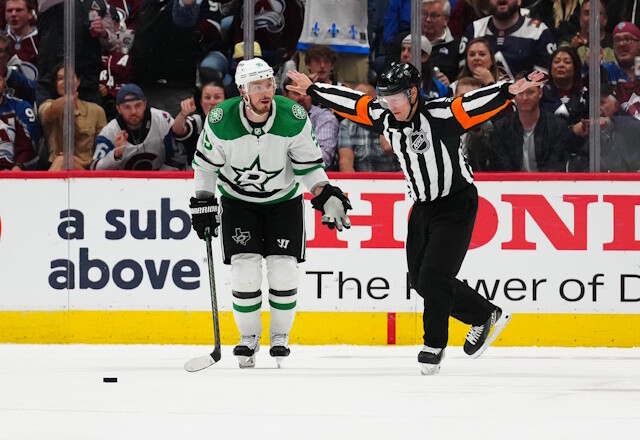The NHL has a glaring goalie interference problem, which has become more apparent, especially in the Stanley Cup Playoffs.
Goalie interference in the NHL is the catch rule for the NFL. Yes, we are bringing SAT analogies to the sports world. While former NHL and Hockey Hall of Fame goalie Henrik Lundqvist thinks there is a Reverse VH pandemic, the more significant pandemic is goalie interference.
No Need For The NHL To Expand the Stanley Cup Playoffs
Since the Sam Bennett goal in Game 4 of the Boston Bruins-Florida Panthers Round 2 series, it feels like every night in the Stanley Cup Playoffs there is a controversial goalie interference goal the NHL has to deal with. Social media does not help the situation, but some calls make you scratch your head.
IT STANDS ?
SAM BENNETT HAS TIED THE GAME IN BOSTON ? pic.twitter.com/8BZuILIG3h
— B/R Open Ice (@BR_OpenIce) May 13, 2024
Just look at Game 5 in that series, with Charlie McAvoy‘s game-winning goal. There was contact with Florida netminder Sergei Bobrovsky, but it was outside the blue paint, and it did not prevent him from resetting and having a chance to make a save.
Charlie McAvoy gives the Bruins the lead ?
The Panthers challenged the goal for goaltender interference, but were unsuccessful.
Was it the right call?
(?: @BR_OpenIce)pic.twitter.com/sj4G8v7kEC
— BarDown (@BarDown) May 15, 2024
Unlike Bennett’s goal, Bruins’ goalie Jeremy Swayman could not make a save as Bennett shoved Bruins forward Charlie Coyle into Swayman. Though the NHL said the shove did not affect Swayman’s ability to play his position, it did.
NHL Rumors: Changes Are Coming with the Carolina Hurricanes
The league’s logic on that goal had to be applied to the McAvoy Goal to allow it to stand. Again, the NHL does not like to take goals off the board, but the logic on offside reviews and goalie interference is inconsistent.
You can even look at Round 1 of the Stanley Cup Playoffs, the Panthers-Tampa Bay Lightning series. Lightning head coach Jon Cooper did not like some calls in that series—especially the two goals in Game 5 that were called back for goalie interference.
Anthony Cirelli‘s goal is overturned after review. pic.twitter.com/x7Pz8VE9Fz
— Sportsnet (@Sportsnet) April 29, 2024
The referee waived off Tampa Bay’s goal because Cirelli was in the crease. pic.twitter.com/SGHdp4aaKM
— Sportsnet (@Sportsnet) April 30, 2024
Whether you want to believe his comments about how goalies need to fight through more traffic in front, the inconsistencies in goalie interference from game to game and series to series have become a problem for the NHL.
Let’s go to the latest examples of goalie interference—first, the Mason Marchment goal in Game 6 of the Dallas-Colorado series in overtime.
Mason Marchment and the Dallas Stars thought they had the series-winner but the goal was waived off due to goalie interference.
The call on the ice stands after review. pic.twitter.com/UCieYk9hZF
— Sportsnet (@Sportsnet) May 18, 2024
Marchment scores the game-winner on the goal. Matt Duchene is outside the blue paint and is pushed into Avalanche goalie Alexandar Georgiev by defenseman Cale Makar.
NHL Rumors: Julien BriseBois Hopeful To Keep Steven Stamkos
The logic behind the no-goal call was Duchene’s butt was in the blue paint preventing Georgiev from playing the position. However, the video shows that Makar pushes him into Georgiev, and the goal should have counted.
As the old saying goes, the puck does not lie, and the rightful team won when Duchene scored the winner in Double OT to allow the Stars to advance to the Western Conference Final.
We’re going to Game 6 of the Vancouver-Edmonton Series. Late in period one, the Oilers think they have a 2-1 lead, but it is called back for goalie interference.
This was called no-goal on the ice for goaltender interference ? pic.twitter.com/OnkY1HFJ4X
— B/R Open Ice (@BR_OpenIce) May 19, 2024
Connor McDavid goes into the blue paint unabated and jumps into Canucks goalie Arturs Silovs preventing him from playing his position. It was the right call on the ice and the right decision by Oilers head coach Kris Knoblauch not to challenge it.
However, the standard in all of these calls is not consistent. That is confusing for the players and coaches regarding the rules.
NHL Rumors: Several Teams Will Be Looking for a New Goalie This Offseason
Suppose the blue paint is the goalie’s home. If that is the case, he must be able to play his position regardless of whether the attacking player makes contact, is pushed in, or pushes the defender into the goaltender. The goal should not count. That takes the subjectivity out of the referees’ rulings.
Yes, the goalies should fight through traffic, but nobody knows the rule anymore.
Considering some of its partners and advertisers, it opens up the league to scrutiny, which we do not get into here. The integrity of the game must be protected, and some of these goalie interference penalties in the NHL have many people questioning that right now.
Goalie interference will continue to be debated until the NHL clearly defines how they apply Rule 69.1 to their decisions.


